Back to Blog Home
4 successful agency pricing models (with real examples)

[Hide]
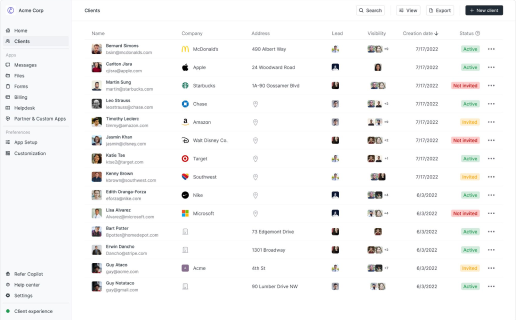
Run your agency with Copilot
Copilot gives you the tools you need to start, run, and grow your client business. Try it for free!
4.9 rating
Pricing is one of those things that can be daunting for every business owner just starting out.
Knowing how much to charge, and how often, will set the stage for how healthy of a business you’ll be able to create. I mean, after all, without getting paid, you won’t have a business.
So if you want to run a lean, competitive, and financially stable business — and why wouldn’t you? — one of the first things you need to figure out is your agency pricing model.
In this article, we’ll take a deep dive into the best pricing models so you can choose the best option for your agency.
Why it’s important to choose the right agency pricing model
Choosing the right agency pricing model is about far more than just getting paid. It also influences a lot of other important aspects of your business, too. Before we share the most popular models that agencies around the world use to charge clients, let’s explore the reasons why you need to get your pricing right.
Business operations
Your agency pricing model has a significant effect on your revenues. However, you need to think beyond what you take home each tax year. Setting your prices and your model dictates how you can cover costs, pay for employees and contractors, and how much money you have to reinvest in your business for things like equipment, marketing agency tools, and human capital.
Perception of value
Your agency pricing model affects your client’s perception of whether your service provides value. For example, charging an hourly rate or a flat monthly fee, and your client will focus on what you achieve within that time, with no promise that your work will make an impact. However, if you embrace a performance-based model, clients only pay for the results you generate.
Competition
Competing on price is one thing; competing on pricing models is another. It’s hard to compete against other agencies in your niche, which is why many businesses slash their prices. The problem with that approach is that you’re stuck trying to cover costs and make a profit on tight margins.
If you want to stand out against rival agencies, offering an alternative business model can work. For example, if other agencies use an hourly or day rate to charge their clients, you can compete with a flat monthly subscription with clearly defined deliverables. In some situations, that type of model will prove more attractive to your clients.
Client relationships
Your pricing model can even play a role in client relationships. Part of this is about the perception of value, which we’ve discussed above. The other part is about providing transparency and clarity. For example, a productized or subscription service business model outlines the client’s expectations in no uncertain terms, which can help foster trust and loyalty.
Time and resource allocation
Whichever agency pricing model you choose will also dictate what sort of contracts or arrangements you choose. For example, if you charge hourly, it’s natural to seek work that allows you to maximize your billable hours. On the other hand, a value-based model means you will identify contracts where you can have a measurable impact on revenue and take a cut.
Scale
Getting paid per hour or by project is difficult to scale because you can only bill for so much time per month. However, other models, like retainer or performance-based payments, are more amenable to scale. So, think about your business objectives over the long term when you’re picking the right model for you.
Ok, now that you understand the impact that agency pricing models can have on you, your clients, and your business objectives, it’s time to study the different models you can apply as an agency.
4 agency pricing models that actually work
Here are the four main agency pricing models:
Alright, let’s go through examples and the pros and cons of each of these models.
1. Hourly pricing
Hourly pricing is one of the most common cost structures among agencies. It works fairly simply, which explains some of the appeal. An agency sets a predetermined hourly price for their service and invoices their client based on how long a project or set of projects takes.
The good thing about hourly pricing is that you ensure you get compensated for the actual time you spend on a project. This arrangement makes it easier to deal with things like scope creep or unexpected additional work on a project.
However, you do need to find a way to justify each hour of work. You can do this by keeping a work diary. Alternatively, there are lots of project management tools that come with time-tracking capabilities. These tools provide value for both you and your clients because you can automate your hours and invoices, and your clients can easily control their budgets. So, make sure they are part of your agency tech stack.
A big advantage of the hourly pricing model is its flexibility. Your clients can easily add tasks or adjust projects and pay for the additional work they receive, making it ideal for ongoing and one-off projects.
Of course, no model is perfect. One of the big issues with hourly pricing is that monthly or annual revenues are irregular and hard to predict. However, there are alternative models that are more geared toward recurring revenue, which we will share later in this article.
Pros and cons of hourly pricing
Pros
- This pricing model is very simple to understand and implement.
- Clients don’t need to pay a large fee upfront.
- Hourly pricing offers a lot of flexibility and works well in scenarios with unpredictable workloads.
Cons
- Clients might have questions about how productive you are during each hour.
- Hourly pricing pits your profitability against your clients.
- This model is challenging to scale without hugely boosting your efficiency.
How to set your hourly price
There are lots of different factors that go into setting your hourly rate. Let’s look at the two most common approaches.
Market-based pricing
In industries with a lot of competition, market-based pricing might be your best bet. While many clients want quality at any cost, others are more interested in getting as much value as possible from their agency. As such, other agencies can influence the hourly rate you charge.
If you’re just starting out, you can find the average cost via competitor analysis. This research can help you gauge your pricing, but it’s not an exact science.
Cost-based pricing
Cost-based pricing looks at what it costs you to deliver your service and adds an acceptable profit margin on top. For smaller agencies, costs can be fairly minimal and constitute things like utilities, equipment, and, of course, your time. However, once you start adding in employees and office rents, costs can rise dramatically.
Agencies in coastal cities typically charge more to reflect higher costs of living, rents, and salaries. As such, their cost-based hourly rate will be more than, for example, a Midwestern business. Of course, as remote work has emerged, it does represent an opportunity to compete with companies around the nation, but without the typical costs of doing business.
Example of the hourly pricing model
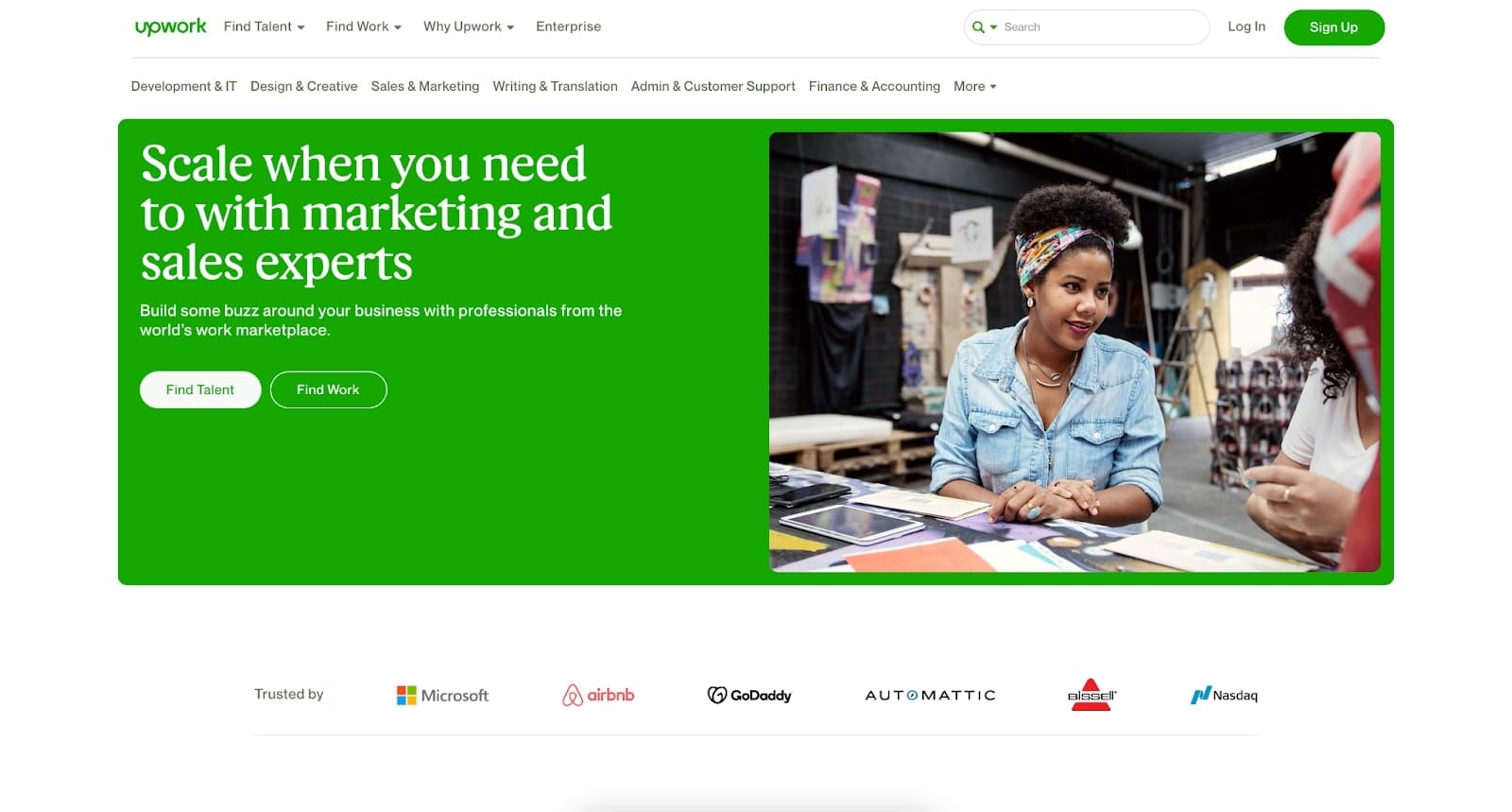
If you need a good example of the hourly pricing model, look no further than freelancers or small agencies on Upwork. These agencies typically have a standard hourly rate that they use to attract clients.
However, it’s important to note that Upwork also provides flexibility to bid per project or milestone, too.
2. Retainer
The retainer pricing model typically involves clients paying a monthly or quarterly fee to “retain” your agency's service during that time. That monthly or quarterly fee will usually contain something like:
- An agreed set of hours.
- Specific tasks.
- A clearly delineated scope of work.
When compared to hourly charges, there is a bit more discussion to trash out with the client. However, once you’ve ironed out an agreement, there is less admin involved.
One interesting way to cut back on admin while offering a retainer service is by adopting a productized service business model. These models work because they establish clear boundaries around what each client can expect from your service. What’s more, these packages are sold like a product, which makes invoices and billing very straightforward.
Overall, the retainer agency pricing model will only work for specific scenarios. It’s a good choice for agencies that offer services that are built on consistency and long-term relationships, such as SEO or digital marketing. These arrangements mean agencies and clients can build deeper relationships and better, more fruitful collaborations.
Pros and cons of retainer pricing
Pros
- Helps agencies secure consistent and predictable revenue, making it easier to manage resources.
- Agencies with predictable revenue can focus more on delivering value for their clients and spend less time on sales and marketing.
- Retainers help agencies focus time on retention and developing stronger relationships.
Cons
- For a variety of reasons, clients come and go, and sometimes abruptly. Overreliance on a retainer for a big client might leave your agency in a vulnerable spot if you lose their business.
- Scope creep becomes an issue if clients want to request more work than initially anticipated.
- If your roster gets too full, it means you’ll need to turn down ad-hoc work and potentially miss out on developing other relationships with clients.
How to set your retainer rate
Setting retainer pricing is a little tricky for new or inexperienced agencies. However, you can use this method to set your retainer prices.
Firstly, work out your hourly or per-project rate. Add in your overheads, such as staff, software subscriptions, rent, utilities, and so on. From there, estimate how much time and resources each retainer service will cost you to deliver, factoring in any additional value you offer, such as expertise, specialist knowledge, or experience.
From there, you can build various tiers based on the scope of work, deliverables, potential clients' budgets, and so forth. Ideally, you want to leave a little wriggle room to ensure you can deliver great service without overextending yourself and taking too much time away from other projects or clients.
Example of the retainer/subscription pricing model
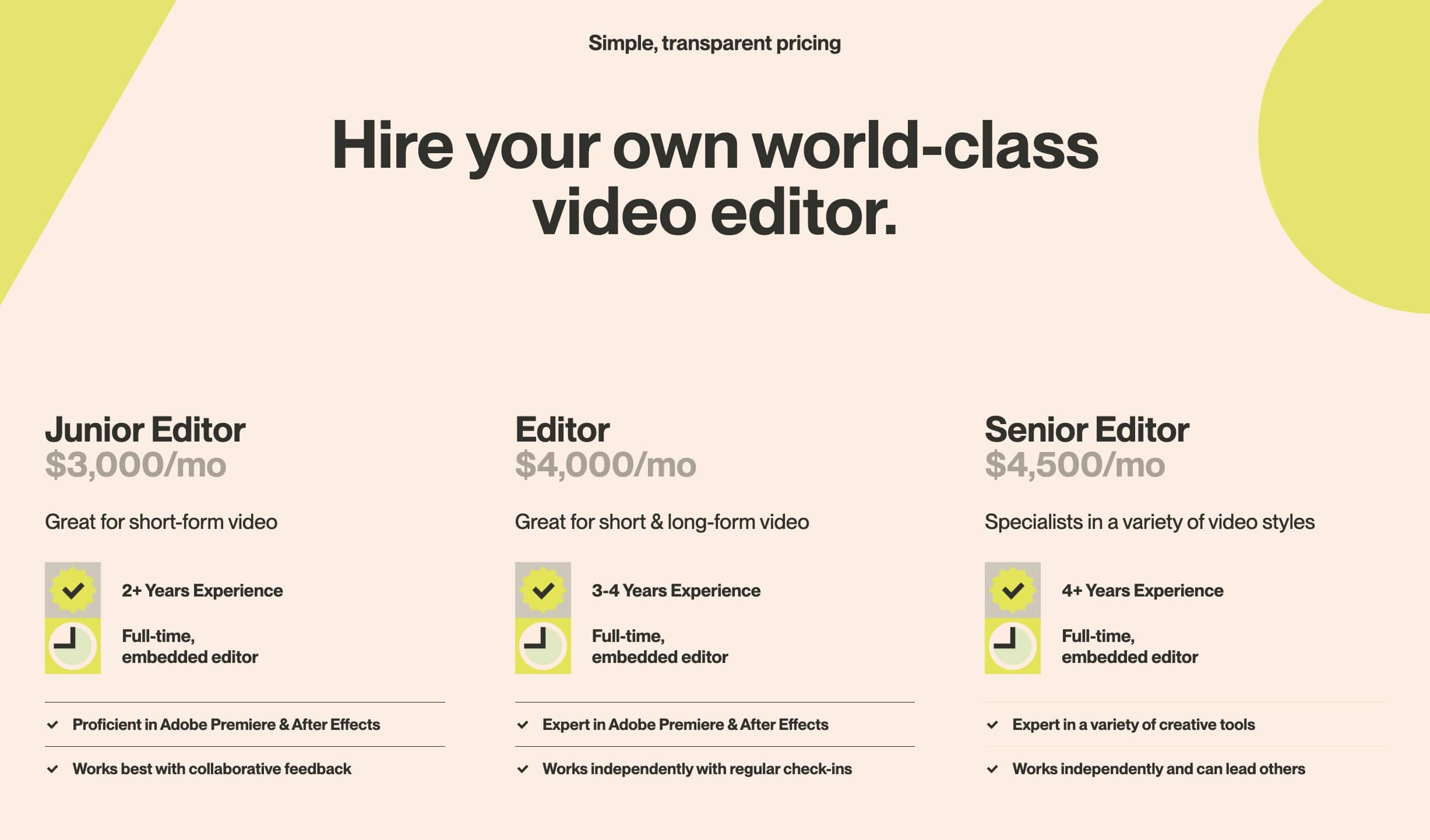
ViralCuts is a video-editing service that connects clients with first-rate video editors around the world. It’s a great option for teams that produce a lot of videos and don’t have the time to find and assess new editors for each one.
Understandably, ViralCuts is the perfect type of business for a retainer pricing model. They offer different tiers of productized services based on editors' experiences. Each retainer gives a client 40 hours per week with a dedicated editor.
3. Performance-based
The performance-based pricing model ties your agency fees to a metric or set of metrics that measure the impact of your work. These arrangements are dramatically different from hourly or project-based work. However, they do introduce a level of unpredictability into your work, which means they won’t work for every agency.
Some examples of performance-based agencies include things like payment based on the number of sales or leads generated by the marketing agency each month. Instead of paying a flat or hourly fee, your client pays for each opportunity.
Performance-based models are a bit of a double-edged sword. In the worst-case scenario, this model can mean your agency invests a lot of time and resources into working for a client but for little reward. In other cases, you can generate revenue well in excess of your effort if a campaign takes off. Either way, it means abandoning thoughts of predictable revenue and, instead, betting on yourself or your agency.
For clients, there is a lot of appeal about working with a performance-based agency. In particular, it removes an element of risk because if the agency does not perform well, they don’t get paid. As such, it’s only advisable to adopt this financial model if you have absolute confidence to deliver impactful results.
Another important thing to consider is that some KPIs and metrics are hard to track and attribute. For example, let’s say you are a digital marketing agency, and you charge based on revenue generated by your campaign. Accurately tracking which of your actions led to sales can be difficult. What’s more, you’ll need to trust your client to report revenues to ensure you get your cut accurately.
Pros and cons of performance-based pricing
Pros
- Potential to earn high volumes of revenue if you can deliver great results for your client.
- Performance-based pricing is a great idea for clients because they only pay for results.
- Ensures that agencies stay focused on generating tangible results.
Cons
- Revenue is not assured, which means poor luck or unforeseen market changes might leave your agency struggling financially.
- This model will only work for certain situations and industries, which means you’ll have a far narrower base of potential clients.
- This model can occasionally lead to prioritizing short-term success over more long-term and sustainable actions.
How to set your performance-based pricing rates
Determining performance-based pricing seems complicated at first glance. However, it’s fairly straightforward to do with the right kind of planning.
For starters, agree to outline the KPIs and metrics that you will measure to determine success. That can be leads, sales, web traffic, or whatever custom metrics work for your client. From there, you need to establish your client’s current performance as a baseline and then set realistic targets for what you can do.
Next up, you must determine what each conversion is worth to your client. From there, you can take a percentage of this value, or agree to a flat rate based on averages. If you go with a flat rate, you might want to work in a way that will give you a bonus for larger deals or for exceeding expectations.
Finally, in the interests of transparency, you’ll need to work out a way to have some visibility over results. Analytics platforms with shared dashboards can work out very well in these situations.
Example of the performance-based pricing model
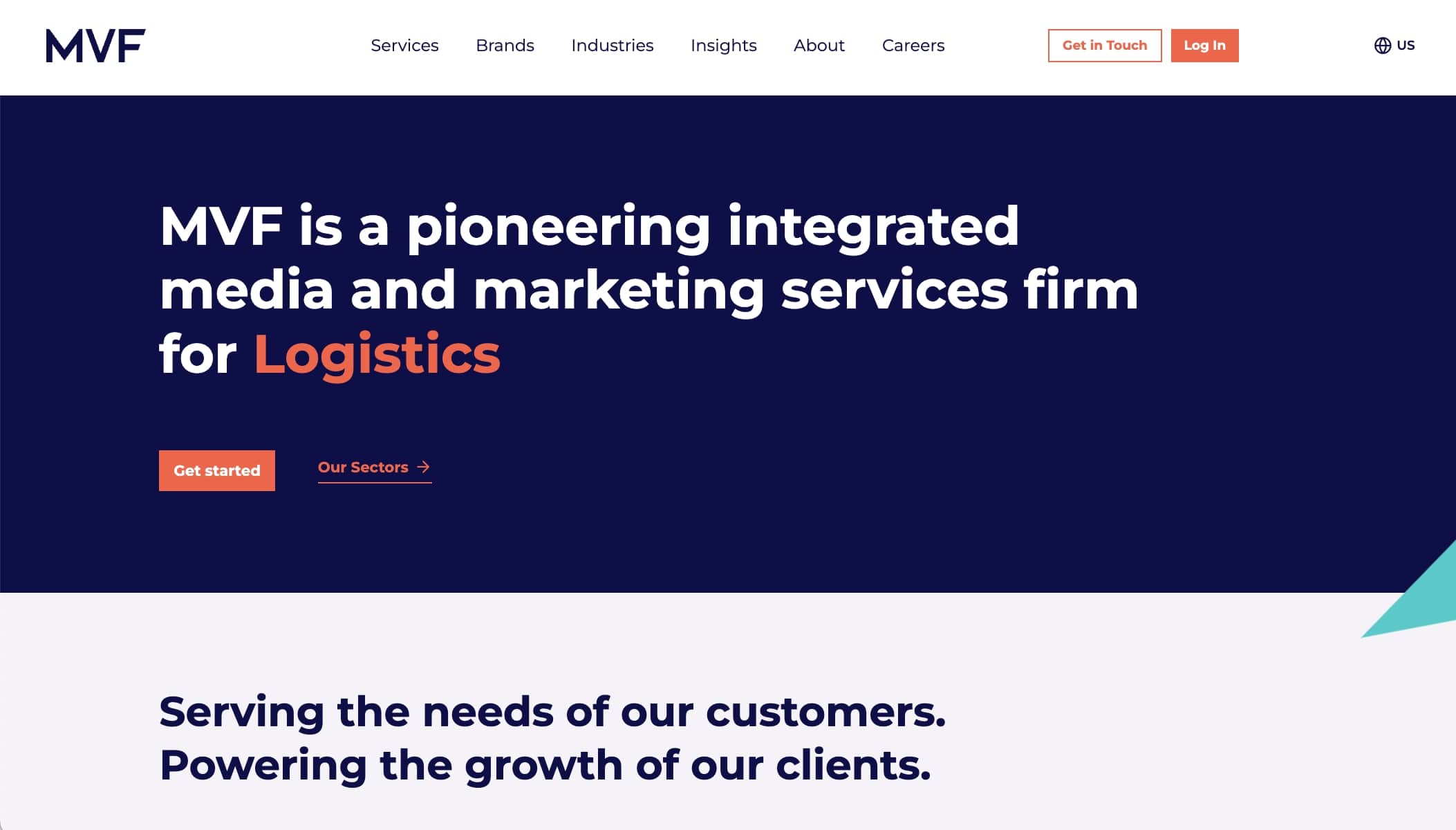
MVF Global is a marketing and market research company that helps connect businesses with relevant leads and customers. They work across a wide range of industries and are well-known for generating high-quality leads.
Instead of charging clients per hour or per campaign, they use a performance-based pricing model that takes a share of profits generated from their campaigns. It takes some confidence in your ability to produce consistent results to offer this service. For established names like MVF with solid operating models and a track record of success, it makes all the sense in the world.
4. Project-based
The project-based agency pricing model is frequently used across a diverse set of industries. This agency business model is fairly straightforward and involves charging a fixed fee for a project or a deliverable.
While it’s not necessarily standard across the industry, web design is a good way to show how the project-based agency business model works. For example, let’s say a client contacts you to say they have a new business and they need a website.
Now, each website is different. So, while you could offer a productized service based on a standardized website, it might not provide enough customization for each client. Instead, the best way to estimate the cost for this project is by sitting down with the client, establishing what they want, and working out the costs based on delivering that site.
The project-based pricing model works for clients because they pay a flat fee for the job. However, this underlines the importance of outlining expectations and deliverables.
Pros and cons of project-based pricing
Pros
- Project-based prices are predictable for clients and agencies.
- Delivering projects as efficiently as possible becomes an operational priority.
- Project management, budgeting, and financial planning become more straightforward.
Cons
- If the project scope changes, it can introduce a few issues with charging.
- Margins hinge on your ability to price jobs accurately.
- Lacks the predictable revenue associated with other agency pricing models.
How to set your project-based pricing rates
Project-based pricing comes with a few complexities. However, with enough experience, you’ll soon get a sense of how you should set your rates, particularly if projects have similar features.
If you’re just starting out, here is a good process to follow to set project-based rates.
Firstly, calculate the staff hours, resources, and materials you need to complete the project. Then, consider your desired profit margins and add them to your budget. However, there are other things that you need to think about, too.
Much of the same advice on setting hourly rates applies here, too. While we’ve shared a cost-based pricing model above, depending on your market, expertise, and experience, you might be able to take a more value-based pricing approach. In effect, if you can offer your clients the kind of service or results they’ll struggle to get elsewhere, you can charge a premium.
Example of the project-based pricing model
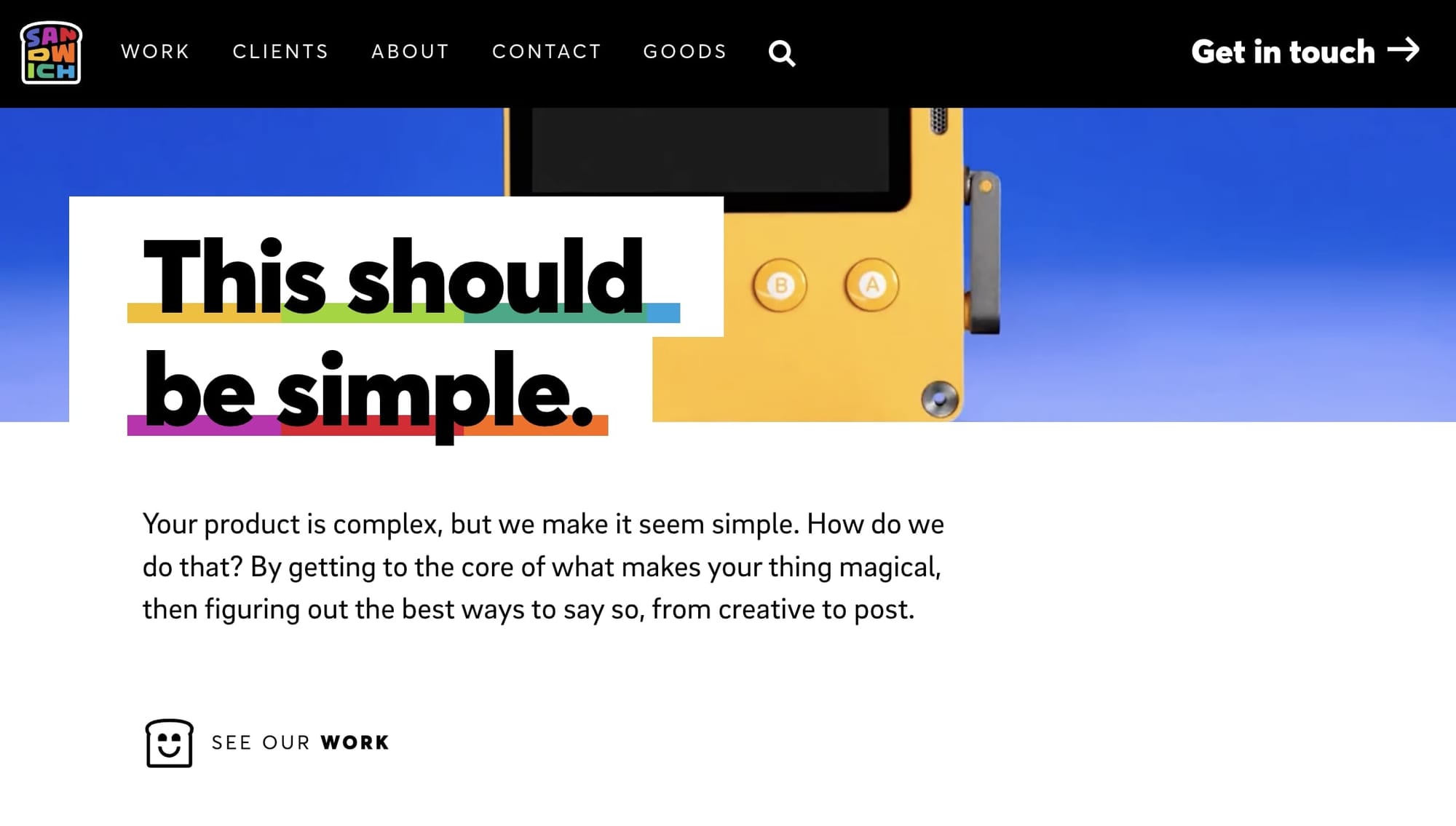
Sandwich is a Silicon Valley-based creative studio. They work in marketing and have made video ads for some huge startups. Understandably, budgets and objectives vary wildly from client to client, which is reflected in their agency pricing model.
While not every agency makes commercials, the principles of Sandwich’s project-based pricing are transferable: figure out what each client needs and tell them how you can deliver it and with what budget.
If you’re worried about scope creep’s effect on your margins, draw up a legal agreement that clearly defines the deliverables and establishes a price for extra work. Trust us, it will help you avoid some awkward situations and conversations over the long term.
What is the best agency pricing model for me?
The best agency pricing model for any business depends on a few different factors, including your service, agency size, competition, target audience, and even your business goals. In other words, there is no “right” pricing model. Each model has its own pros and cons, which we have shared with you above.
The most important thing, especially when you are starting out, is to try to strike a balance between providing value and getting paid. While tightening your profit margins so you can win market share from your rivals is a tried-and-tested approach, beware of committing yourself to projects that just aren’t worth it.
Conclusion
Getting your agency pricing model sorted is a vital step for any new business. However, managing your agency efficiently is just as important. Copilot comes with a wide range of tools that are tailor-made for agency management, including automated contracts and onboarding, a sophisticated billing app, and a polished, white-label client portal for managing document sharing and messaging.
Start your 14-day free trial today to see why agencies across the land are turning to Copilot to help them manage their business and provide superb client experiences.
Share this post
Sign up for our newsletter
Subscribe to our newsletter to receive emails about important announcements, product updates, and guides relevant to your industry.
